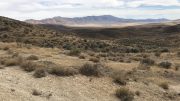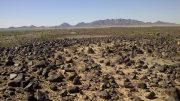The U.S. southwestern states continue to be a hotbed of junior activity in exploration, development and mining, with gold, silver, copper and lithium still the targets of choice. The following is a sampling of seven such companies with active programs in the region.
AMERICAN PACIFIC MINING
American Pacific Mining (CSE: USGD) describes itself as a new gold explorer focused on precious metal opportunities in the Western United States. Warwick Smith serves as CEO and a director.
The company’s flagship Tuscarora property in Nevada’s Tuscorora mining district is a high-grade, early stage gold project located 35 km northeast of the Carlin trend, 20 km southwest of the Jerritt Canyon deposit, and 50 km northeast of the Midas deposit.
During mid-2018, American Pacific completed 3,050 metres of reverse-circulation and core drilling at Tuscarora and says that it confirmed previous high-grade mineralization in the South Navajo zone, and extended known mineralization 450 metres north with hole 13.
The geology seen at Tuscorora is described as high-level, low-sulphidation, epithermal style, and the property lies at the foot of Mount Blitzen on the eastern slope of the Northern Tuscarora Range — an area known for extensive precious metals exploration and mining in the past.
CALIFORNIA GOLD MINING
Toronto-based junior California Gold Mining (TSXV: CGM; US-OTC: CFGMF) is steadily advancing its wholly owned flagship Fremont high-grade gold project in central California.
The property is 150 km east of San Francisco in relatively pro-development Mariposa County, on 14 sq. km of patented land in the prolific Mother Lode gold belt that has historically produced over 50 million oz. gold.
Total open-pit resources calculated in 2016 stand at 17.2 million indicated and inferred tonnes grading 1.60 grams gold per tonne for 879,000 contained oz. gold.

Looking north along drill roads at California Gold’s Fremont gold project in California. Photo by Katie Lister.
The company acquired the property in 2013, and as of mid-2018 had carried out four phases of drilling totalling 16,100 metres, and preliminary metallurgical testing showing 93% recoveries from an oxide cap and 86% from sulphide zones.
The company is led by president and CEO Vishal Gupta, a geologist and former mining equity analyst.
In a sign of the times, the company recently submitted an application to Mariposa County seeking approval for the cultivation of industrial hemp on the property. It says the proposed operations would include the “construction of a 20,000 sq. foot greenhouse, to be primarily used for the propagation of industrial hemp seeds, along with the development of a 100-acre agricultural farm for the cultivation of an industrial hemp crop, and the construction of a 5,000 sq. foot facility for the processing of the crop raw material.”
CYPRESS DEVELOPMENT CORP.
Cypress Development (TSXV: CYP; US-OTC: CYDVF) is focused on developing its fully held Clayton Valley lithium project in Nevada.
Cypress says it has “discovered a world-class resource of a leachable, lithium-bearing claystone next to the Albemarle Silver Peak mine — North America’s only lithium brine operation. The size of the resource makes the Clayton Valley project a premier target with the potential to impact the future production of lithium for the fast-growing global lithium-ion battery market.”
In October, Cypress filed a preliminary economic assessment (PEA) of the project and launched into a prefeasibility study.
The PEA showed a 33% internal rate of return; a US$482-million capital cost; a US$1.45-billion net present value; and a 40-year mine life at a mining rate of 15,000 tonnes per day.
Cypress says the upcoming study will include infill drilling to upgrade resource categories and optimize the production schedule within the mine area. Metallurgical testing will include determining optimum leach conditions and configuration of the process plant, as well as further testing at the bench-scale to demonstrate production of high-purity lithium carbonate suitable for battery usage.
KERR MINES
Toronto-based Kerr Mines (TSX: KER; US-OTC: KERMF) is working to redevelop the fully permitted, past-producing Copperstone gold property located along the Walker Lane mineral belt in Arizona.
Copperstone produced over 500,000 oz. gold from an open pit in the past, but left behind a high-grade, measured resource of 934,000 tonnes at 10.4 grams gold per tonne for 311,000 contained oz. gold. Another 335,000 tonnes at 12.2 grams gold lie in the inferred category.

At Aben Resources’ Forrest Kerr gold project in B.C., from left: director Timothy Termuende, CEO James Pettit and VP of exploration Cornell McDowell. Credit: Aben Resources.
Kerr has hit several milestones in the past few months: selling its remaining interest in the McGarry mine and Barber-Larder properties to Orefinders Resources (TSXV: ORX) for 8 million shares, or 9%, of Orefinders, plus 440,248 shares in Orefinders battery metals spinoff Power Ore (TSXV: PORE); securing a project financing for up to US$25 million from Sprott Private Resource Lending; and lining up a $2.5-million private placement.
Kerr says it is on track for first production in early 2020, with a prefeasibility study pointing to initial capital costs of only US$22.7 million to build a mine capable of initially producing at a rate of 38,000 oz. gold annually for 4.5 years.
MCEWEN MINING
McEwen Mining (TSX: MUX; NYSE: MUX) is making swift progress at its Gold Bar gold mine project in central Nevada and has confirmed that commercial production will begin in the first quarter of next year.
The company completed the heap leach pad and installed crushing, conveying and agglomeration systems in November, and for the rest of 2018, its focus will be on finishing the process plant — which is 70% complete — commissioning, and starting to load the heap-leach pad.

High-grade gold in RC drill samples from McEwen Mining’s Gold Bar project in Nevada. Hydrothermal fluids decalcify carbonate host rocks in Carlin-style gold deposits, leaving behind gold and clay. Photo by Lesley Stokes.
The mine is expected to produce an average of 62,000 oz. gold a year over a seven-year mine life at cash costs of US$770 per oz. and all-in sustaining costs of US$843 per ounce.
A feasibility study in February estimated capex of US$81 million, and a payback of three years based on US$1,250 per oz. gold. The study forecast a 23% post-tax internal rate of return and a US$54-million after-tax net present value at a 5% discount rate.
Rob McEwen-led McEwen Mining already has three operating mines: its Black Fox gold complex in Ontario’s Timmins district, its aging El Gallo gold-silver mine in Mexico and its 49%-owned San Jose gold-copper mine in southern Argentina.
Development projects include the Gallo Silver project near the El Gallo mine, and the large, low-grade Los Azules copper asset in Argentina’s San Juan province.
NORTHERN VERTEX MINING
Less than a month after Northern Vertex Mining (TSXV: NEE; US-OTC: NHVCF) signed a US$8.5-million silver stream financing with Maverix Metals (TSXV: MMX), the company has reached a deal with existing shareholder and private equity firm Greenstone Resources for an unsecured, US$10-million working capital facility.
Northern Vertex’s open-pit, heap-leach Moss gold-silver mine in Arizona is the newest mine in the U.S., reaching commercial production in September. The mine is expected to produce an average of over 50,000 equivalent oz. gold a year over the first four years of a 10-year mine life.

Northern Vertex Mining milling facilities, which could process 5,000 tonnes daily over five years by March. Credit: Northern Vertex Mining.
The company financed the mine and completed construction in less than two years.
Northern Vertex expects Moss will produce 32,000 to 36,000 oz. gold and 224,000 to 248,000 oz. silver (36,000 to 40,000 equivalent oz. gold) in the 2019 fiscal year ending on June 30.
Moss’s gold-silver stockwork, brecciated, low-sulphidation epithermal system outcrops for over 1.5 kilometres.
The mine, Northern Vertex’s flagship asset, is 9 km from Bullhead City and 8 km from a state highway.
The company says it plans to become a mid-tier gold producer with over 200,000 oz. gold production a year, and expects to achieve that goal through mergers and acquisitions.
PREMIER GOLD MINES
Ewan Downie-led Premier Gold Mines (TSX: PG; US-OTC: PIRGF) is in the consolidation phase after a rapid growth spurt that saw it become operator of gold mines in Nevada (South Arturo) and Mexico (Mercedes mine), and a developer of significant advanced gold projects in both jurisdictions, as well as northwestern Ontario.
South Arturo is 60% owned by operator Barrick Gold (TSX: ABX; NYSE: ABX) and 40% by Premier, which bought its stake from Goldcorp in 2015. The open-pit mine was brought into production in 2016, with ore sent to Barrick’s roaster at its vast Goldstrike gold operations in the region.

Premier Gold Mines’ Mercedes gold-silver mine in northern Mexico. Credit: Premier Gold Mines.
Premier’s share of production for 2018 is an estimated 20,000 to 25,000 oz. gold at all-in sustaining costs (AISCs) of only US$425 to US$475 per oz. gold. South Arturo continues to be one of the world’s lowest-cost gold mines.
Also in Nevada, Premier has its fully owned, past-producing Cove high-grade gold property, which could be developed into an underground mine.
In March Premier updated the resource estimate at Cove to 614,000 indicated tonnes grading 11.57 grams gold per tonne for 228,000 oz. gold, plus 3.4 million inferred tonnes at 12.17 grams gold 1.3 million oz. gold.






Be the first to comment on "Southwest US Snapshot: Gold, silver, copper, lithium remain high on most-sought list"